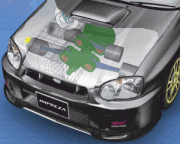WRX History
The Subaru Impreza WRX is a high-powered, turbocharged version of the Subaru Impreza, a small all wheel drive sedan. The WRX has become a popular choice for automobile enthusiasts wherever it is sold for its high performance, excellent grip and handling, practicality, and relatively affordable price (approximately $25,000).
Originally introduced in 1992 in Japan, then shortly afterwards in Australia and Britain, the WRX had a turbocharged flat-4 2.0 L engine producing 208 horsepower. From the 1997 model and later model, the WRX offers 250 horsepower. Compared to the base Impreza, the WRX had wider low-profile tyres, larger brakes (further improved in later versions with the fitment of four-piston calipers and larger discs), and firmer, higher quality suspension components. Offering the performance and handling of vehicles of far higher cost, it rapidly became popular with enthusiasts worldwide. Indeed, it gained a reputation as a popular getaway car for robberies because the car's precise, yet forgiving, handling meant that even inexperienced drivers were able to handle it at high speeds.
The current WRX is based on the Peter Stevens designed Subaru Impreza WRC. The now famous instructions given by Prodrive boss David Richards were to make a car that "looked like it was doing 100 mph, even when it was standing still in a car park".
A series of low-volume versions with even greater power and grip were built by Subaru's in-house modifier, Subaru Tecnica International (STi). STi versions of the Impreza, which produces 300 horsepower from new, are often raced, largely unmodified, in production car circuit racing and stock classes of car rallies to great success. Introduced in 1994, the STi has proven to be a very popular high(er)-performance machine in the Japanese domestic market.
In the 2002 model year, an all-new version of the car was released, finally appearing in the United States, with an engine rated for 227 hp and 217 ft-lb of torque. The USDM engine produced far less power than Impreza WRX offered elsewhere in the world due to the modification done on the engine to satisfy the US emission regulation. To celebrate the debut of the STi in the European market, 1,000 special "ProDrive" models were produced with exclusive ProDrive interior items designed by Peter Stevens. The Impreza WRX was on Car and Driver magazine's Ten Best list for 2002 and 2003.
While the new model was more refined and handled better, it was not as popular with enthusiasts since its greater weight (approx 3100 lb) hampered performance slightly, although 0-60 mph acceleration time takes approximately 5.5 seconds. A higher-powered engine (340 hp) fitted to the Japanese market version remedied that problem somewhat. In addition to the sedan model, a 5-door wagon was offered, and met with brisk sales. Even so, the exterior "bug eyed" styling was widely regarded as somewhat unattractive. As a result, in an unusually early revamp, Subaru updated the style again for the 2004 model year. A third update adorns all 2006 Imprezas, including the performance models, with the controversial "jet intake and wings" grille first debuted on the Subaru B9 Tribeca sport-utility vehicle, along with new headlights, taillights, and bumpers. Opinion on this style is split, but is generally regarded as better applied on the Impreza than the Tribeca.
In the 2004 model year, Subaru began selling the highly performance-tuned WRX STi in the United States, with a 2.5 L engine with AVCS producing 300 hp.
As of the 2006 model year, Subaru updated the US model to use a 2.5 L engine with AVCS that produces 230 hp and 235 ft-lb of torque. The STI model (Subaru has capitalized the I in STI in their promotional literature and website) continues to use a 2.5 L producing 300 hp.
The Subaru Impreza WRX is used as the basis for the Saab 9-2X Aero.

